day08 Thmeleaf
1. 内容讲解
1.1 MVC
1.1.1 为什么需要MVC
曾经编写过下面这段代码
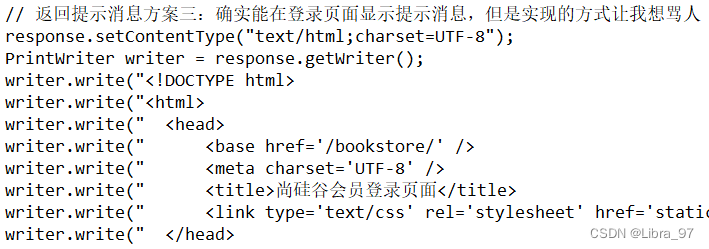
这段代码虽然说可以实现在登录失败之后跳转回到登录页面,并且展示失败信息,但是代码实在是太恶心了,根本没法维护,所以我们需要将视图展示抽取出来,单独作为一个View视图层
但是我们如果只使用HTML作为视图的话,它是无法展示动态数据的,所以我们对HTML的新的期待:既能够正常显示页面,又能在页面中包含动态数据部分。而动态数据单靠HTML本身是无法做到的,所以此时我们需要引入服务器端动态视图模板技术。
1.1.2 MVC概念
M:Model模型
V:View视图
C:Controller控制器
MVC是在表述层开发中运用的一种设计理念。主张把封装数据的『模型』、显示用户界面的『视图』、**协调调度的『控制器』**分开。
好处:
- 进一步实现各个组件之间的解耦
- 让各个组件可以单独维护
- 将视图分离出来以后,我们后端工程师和前端工程师的对接更方便
1.1.3 MVC和三层架构之间关系
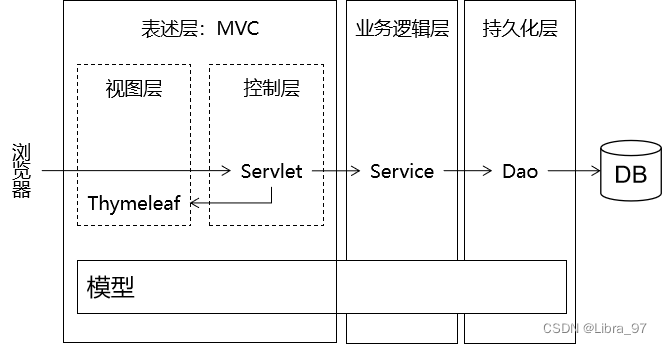
1.2 Thymeleaf的简介
1.2.1 Thymeleaf的概念
Thymeleaf是一款用于渲染XML/XHTML/HTML5内容的模板引擎。类似JSP,Velocity,FreeMaker等, 它也可以轻易的与Spring MVC等Web框架进行集成作为Web应用的模板引擎。它的主要作用是在静态页面上渲染显示动态数据
1.2.2 Thymeleaf的优势
- 22@
<!DOCTYPE html>
<html lang="en" xmlns:th="http://www.thymeleaf.org">
<head>
<meta charset="UTF-8">
<title>Title</title>
</head>
<body>
<p th:text="${username}">Original Value</p>
</body>
</html>
1.2.3 物理视图和逻辑视图
① 物理视图
在Servlet中,将请求转发到一个HTML页面文件时,使用的完整的转发路径就是物理视图。

/pages/user/login_success.html
如果我们把所有的HTML页面都放在某个统一的目录下,那么转发地址就会呈现出明显的规律:
/pages/user/login.html
/pages/user/login_success.html
/pages/user/regist.html
/pages/user/regist_success.html……
路径的开头都是:/pages/user/
路径的结尾都是:.html
所以,路径开头的部分我们称之为视图前缀,路径结尾的部分我们称之为视图后缀。
② 逻辑视图
2. 逻辑视图
物理视图=视图前缀+逻辑视图+视图后缀
上面的例子中:
| 视图前缀 | 逻辑视图 | 视图后缀 | 物理视图 |
|---|---|---|---|
| /pages/user/ | login | .html | /pages/user/login.html |
| /pages/user/ | login_success | .html | /pages/user/login_success.html |
2.1 Thymeleaf的HelloWorld
2.1.1 加入jar包
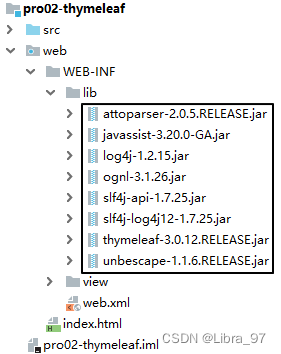
2.1.2 配置上下文参数
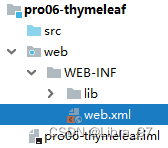
物理视图=视图前缀+逻辑视图+视图后缀
<!-- 配置前缀-->
<context-param>
<param-name>start</param-name>
<param-value>/pages/</param-value>
</context-param>
<!-- 配置后缀-->
<context-param>
<param-name>end</param-name>
<param-value>.html</param-value>
</context-param>
说明:param-value中设置的前缀、后缀的值不是必须叫这个名字,可以根据实际情况和需求进行修改。
为什么要放在WEB-INF目录下?
原因:WEB-INF目录不允许浏览器直接访问,所以我们的视图模板文件放在这个目录下,是一种保护。以免外界可以随意访问视图模板文件。
访问WEB-INF目录下的页面,都必须通过Servlet转发过来,简单说就是:不经过Servlet访问不了。
这样就方便我们在Servlet中检查当前用户是否有权限访问。
那放在WEB-INF目录下之后,重定向进不去怎么办?
重定向到Servlet,再通过Servlet转发到WEB-INF下。
2.1.3 创建Servlet基类
这个类大家直接复制粘贴即可,将来使用框架后,这些代码都将被取代。
package com.atguigu.servlet.base;
import org.thymeleaf.TemplateEngine;
import org.thymeleaf.context.WebContext;
import org.thymeleaf.templatemode.TemplateMode;
import org.thymeleaf.templateresolver.ServletContextTemplateResolver;
import javax.servlet.ServletContext;
import javax.servlet.ServletException;
import javax.servlet.http.HttpServlet;
import javax.servlet.http.HttpServletRequest;
import javax.servlet.http.HttpServletResponse;
import java.io.IOException;
//视图基础类
public class ViewBaseServlet extends HttpServlet {
private TemplateEngine templateEngine;
@Override
public void init() throws ServletException {
// 1.获取ServletContext对象
ServletContext servletContext = this.getServletContext();
// 2.创建Thymeleaf解析器对象
ServletContextTemplateResolver templateResolver = new ServletContextTemplateResolver(servletContext);
// 3.给解析器对象设置参数
// ①HTML是默认模式,明确设置是为了代码更容易理解
templateResolver.setTemplateMode(TemplateMode.HTML);
// ②设置前缀
String viewPrefix = servletContext.getInitParameter("start");
templateResolver.setPrefix(viewPrefix);
// ③设置后缀
String viewSuffix = servletContext.getInitParameter("end");
templateResolver.setSuffix(viewSuffix);
// ④设置缓存过期时间(毫秒)
templateResolver.setCacheTTLMs(60000L);
// ⑤设置是否缓存
templateResolver.setCacheable(true);
// ⑥设置服务器端编码方式
templateResolver.setCharacterEncoding("utf-8");
// 4.创建模板引擎对象
templateEngine = new TemplateEngine();
// 5.给模板引擎对象设置模板解析器
templateEngine.setTemplateResolver(templateResolver);
}
protected void processTemplate(String templateName, HttpServletRequest req, HttpServletResponse resp) throws IOException {
// 1.设置响应体内容类型和字符集
resp.setContentType("text/html;charset=UTF-8");
// 2.创建WebContext对象
WebContext webContext = new WebContext(req, resp, getServletContext());
// 3.处理模板数据
templateEngine.process(templateName, webContext, resp.getWriter());
}
}
2.1.4 入门案例代码
① 创建index.html文件
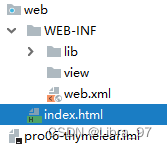
② index.html编写超链接访问Servlet
<h2 th:text="${message}"></h2>
③ 修改Servlet让其继承ViewBaseServlet

④ 在doPost()方法中跳转到Thymeleaf页面
package com.atguigu.servlet.app;
import com.atguigu.servlet.base.ViewBaseServlet;
import javax.servlet.ServletException;
import javax.servlet.annotation.WebServlet;
import javax.servlet.http.HttpServletRequest;
import javax.servlet.http.HttpServletResponse;
import java.io.IOException;
@WebServlet("/index.html")
public class IndexServlet extends ViewBaseServlet {
@Override
protected void doGet(HttpServletRequest req, HttpServletResponse resp) throws ServletException, IOException {
req.setAttribute("message", "helloWorld");
// 请求转发跳转到/WEB-INF/view/index.html
processTemplate("index", req, resp);
}
}
⑤ Thymeleaf页面代码
<!DOCTYPE html>
<html lang="en" xmlns:th="http://www.thymeleaf.org">
<head>
<meta charset="UTF-8">
<title>index</title>
</head>
<body>
<h1>首页 index</h1>
<h2 th:text="${message}"></h2>
</body>
</html>
3. Thymeleaf的基本语法
3.1 th名称空间
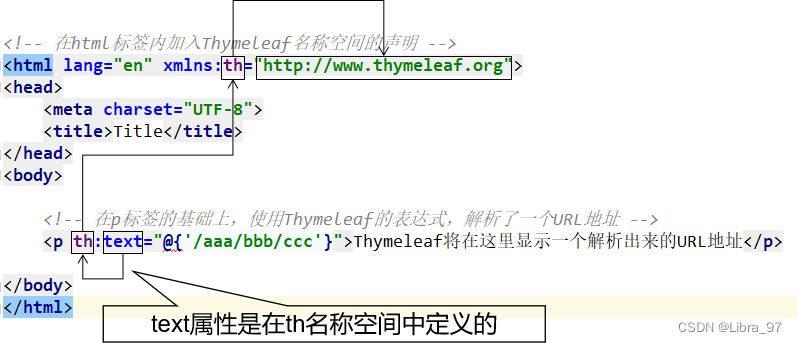
3.2 表达式语法
3.2.1 修改标签文本值
代码示例:
<p th:text="标签体新值">标签体原始值</p>
① th:text作用
- 不经过服务器解析,直接用浏览器打开HTML文件,看到的是『标签体原始值』
- 经过服务器解析,Thymeleaf引擎根据th:text属性指定的『标签体新值』去替换『标签体原始值』
3.2.2 修改指定属性值
代码示例:
<input type="text" name="username" th:value="文本框新值" value="文本框旧值" />
语法:任何HTML标签原有的属性,前面加上『th:』就都可以通过Thymeleaf来设定新值。
3.2.3 解析URL地址
代码示例:
<!--
使用Thymeleaf解析url地址
-->
<a th:href="@{/index.html}">访问index.html</a>
经过解析后得到:
/webday08/index.html
所以@{}的作用是在字符串前附加『上下文路径』
这个语法的好处是:实际开发过程中,项目在不同环境部署时,Web应用的名字有可能发生变化。所以上下文路径不能写死。而通过@{}动态获取上下文路径后,不管怎么变都不怕啦!
① 首页使用URL地址解析
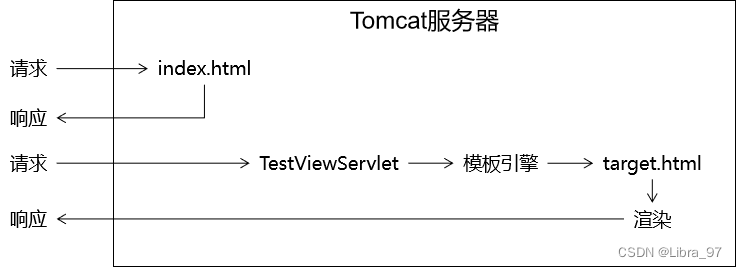
如果我们直接访问index.html本身,那么index.html是不需要通过Servlet,当然也不经过模板引擎,所以index.html上的Thymeleaf的任何表达式都不会被解析。
解决办法:通过Servlet访问index.html,这样就可以让模板引擎渲染页面了:
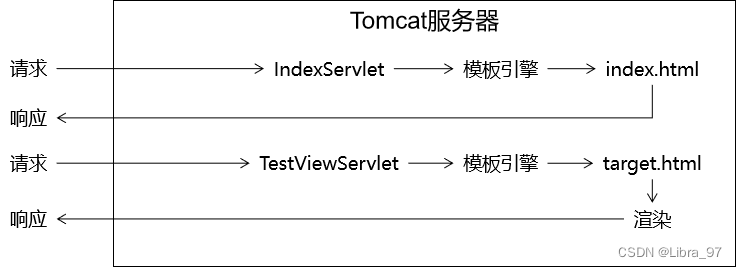
进一步的好处:
通过上面的例子我们看到,所有和业务功能相关的请求都能够确保它们通过Servlet来处理,这样就方便我们统一对这些请求进行特定规则的限定。
② 给URL地址后面附加请求参数
参照官方文档说明:

<a th:href="@{/hello(uname='李四',indexMsg=${indexMsg},hobby='read')}">HelloServlet4</a>
3.3 域对象在Thymeleaf中的使用
3.3.1 回顾域对象
域对象是在服务器中有一定作用域范围的对象,在这个范围内的所有动态资源都能够共享域对象中保存的数据
3.3.2 回顾域对象的类型
① 请求域
在请求转发的场景下,我们可以借助HttpServletRequest对象内部给我们提供的存储空间,帮助我们携带数据,把数据发送给转发的目标资源。
请求域:HttpServletRequest对象内部给我们提供的存储空间
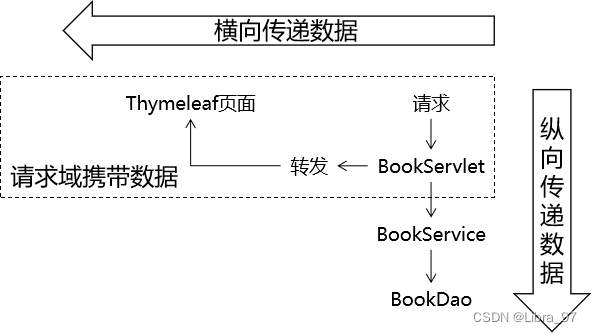
② 会话域(后面学)
会话域的范围是一次会话
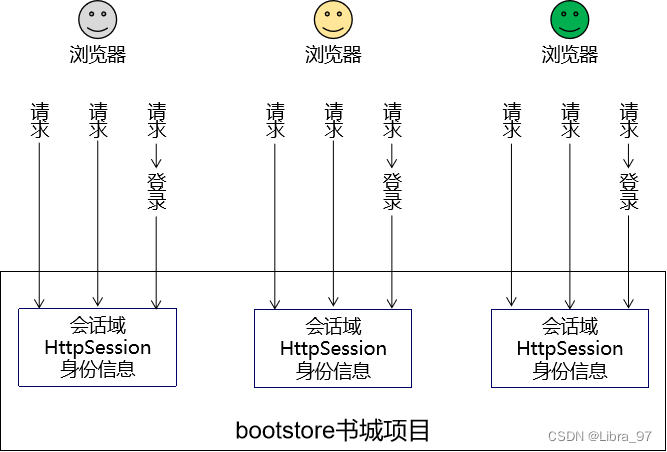
③ 应用域(后面学)
应用域的范围是整个项目全局
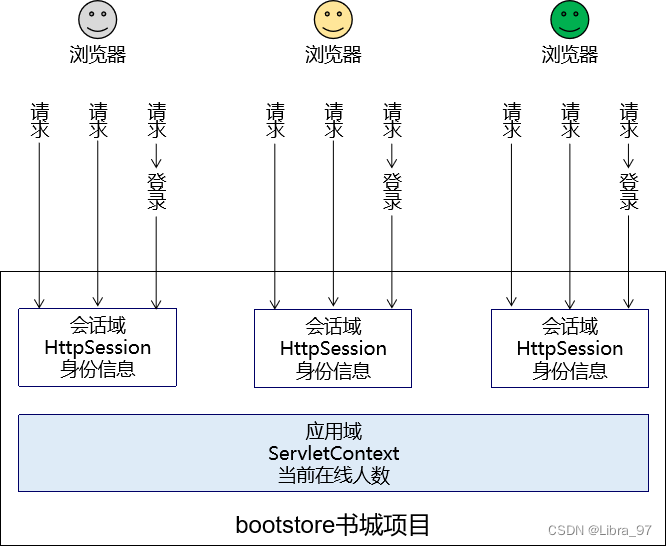
3.3.3 在Thymeleaf中操作域对象
我们通常的做法是,在Servlet中将数据存储到域对象中,而在使用了Thymeleaf的前端页面中取出域对象中的数据并展示
① 操作请求域
Servlet中代码:
req.setAttribute("msg", "独钓寒江雪");
// /pages/ hello.html
processTemplate("hello", req, resp);
Thymeleaf表达式:
<h1 th:text="${msg}">Hello</h1>
② 操作会话域(后期讲)
③ 操作应用域(后期讲)
3.4 获取请求参数
3.4.1 获取请求参数的语法
${param.参数名}
3.4.2 根据一个参数名获取一个参数值
页面代码:
<p th:text="${param.username}">这里替换为请求参数的值</p>
<!--<h3>获取请求参数</h3>-->
<p th:text="${param.uname}"></p>
<p th:text="${param.pwd}"></p>
<p th:text="${param.hobby}"></p>
<p th:text="${param.hobby[0]}"></p>
<p th:text="${param.hobby[1]}"></p>
页面显示效果:

3.4.3 根据一个参数名获取多个参数值
页面代码:
<p th:text="${param.team}">这里替换为请求参数的值</p>
页面显示效果:

如果想要精确获取某一个值,可以使用数组下标。页面代码:
<p th:text="${param.team[0]}">这里替换为请求参数的值</p>
<p th:text="${param.team[1]}">这里替换为请求参数的值</p>
页面显示效果:
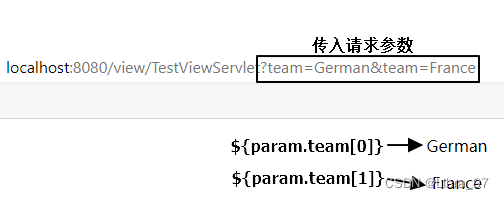
3.5 内置对象
3.5.1 内置对象的概念
所谓内置对象其实就是在Thymeleaf的表达式中可以直接使用的对象
3.5.2 基本内置对象
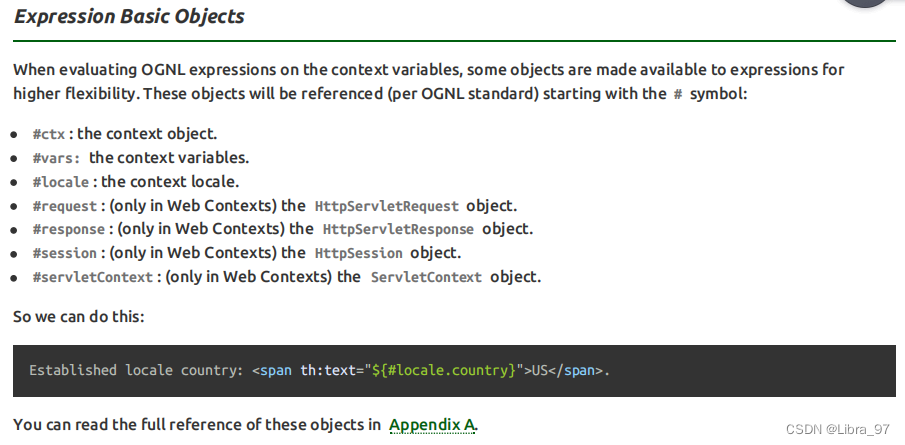
用法举例:
<h3>表达式的基本内置对象</h3>
<p th:text="${#request.getContextPath()}">调用#request对象的getContextPath()方法</p>
<p th:text="${#request.getAttribute('helloRequestAttr')}">调用#request对象的getAttribute()方法,读取属性域</p>
<h3>内置对象(Thymeleaf内可以直接使用的对象)</h3>
<p th:text="${#request.getServletContext()}"></p>
<p th:text="${#request.getContextPath()}"></p>
<p th:text="${#request.getAttribute('msg')}"></p>
基本思路:
- 如果不清楚这个对象有哪些方法可以使用,那么就通过getClass().getName()获取全类名,再回到Java环境查看这个对象有哪些方法
- 内置对象的方法可以直接调用
- 调用方法时需要传参的也可以直接传入参数
3.5.3 公共内置对象
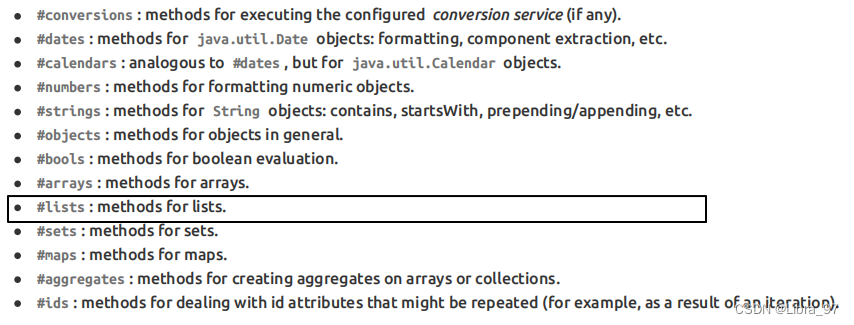
Servlet中将List集合数据存入请求域:
req.setAttribute("msg", "独钓寒江雪");
ArrayList<String > list = new ArrayList<>();
list.add("D");
list.add("B");
list.add("A");
req.setAttribute("myList", list);
// 获取请求参数
Map<String, String[]> map = req.getParameterMap();
map.forEach((k, v) -> System.out.println(k + "--->" + Arrays.toString(v)));
processTemplate("hello", req, resp);
页面代码:
<h3>公共内置对象(等价于Java中的工具类Math)</h3>
<p th:text="${#strings.isEmpty(msg)}"></p>
<p th:text="${#strings.indexOf(msg, '江')}"></p>
<p th:text="${#lists.isEmpty(myList)}"></p>
<p th:text="${#lists.size(myList)}"></p>
<p th:text="${#lists.sort(myList)}"></p>
公共内置对象对应的源码位置:
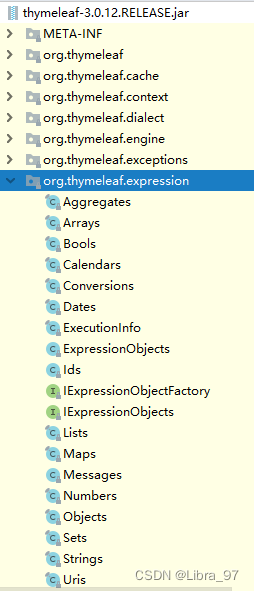
3.6 OGNL
3.6.1 OGNL的概念
OGNL:Object-Graph Navigation Language对象-图 导航语言
3.6.2 对象图的概念
从根对象触发,通过特定的语法,逐层访问对象的各种属性。
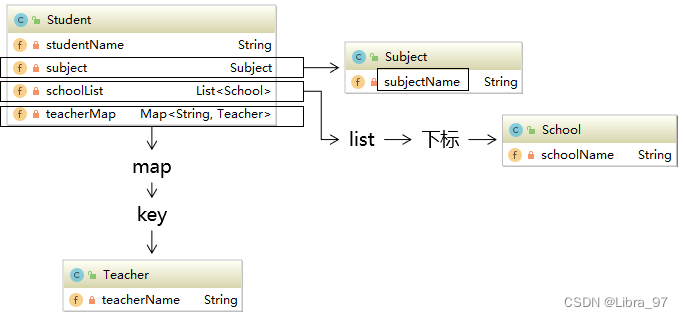
3.6.3 OGNL语法
① 起点
在Thymeleaf环境下,${}中的表达式可以从下列元素开始:
- 访问属性域的起点
- 请求域属性名
- session
- application
- param
- 内置对象
- request
- session
- lists
- strings
② 属性访问语法
- 访问对象属性:使用getXxx()、setXxx()方法定义的属性
- 对象.属性名
- 访问List集合或数组
- 集合或数组[下标]
- 访问Map集合
- Map集合.key
- Map集合[‘key’]
3.7 分支与迭代
3.7.1 分支
① if和unless
让标记了th:if、th:unless的标签根据条件决定是否显示。
示例的实体类:
package com.atguigu.pojo;
public class Person {
private String name;
private int age;
private char gender;
private Computer computer;
public Person() {
}
public Person(String name, int age, char gender) {
this.name = name;
this.age = age;
this.gender = gender;
}
public Person(String name, int age, char gender, Computer computer) {
this.name = name;
this.age = age;
this.gender = gender;
this.computer = computer;
}
public String getName() {
return name;
}
public void setName(String name) {
this.name = name;
}
public int getNum(){
return 20;
}
public int getAge() {
return age;
}
public void setAge(int age) {
this.age = age;
}
public char getGender() {
return gender;
}
public void setGender(char gender) {
this.gender = gender;
}
public Computer getComputer() {
return computer;
}
public void setComputer(Computer computer) {
this.computer = computer;
}
@Override
public String toString() {
return "Person{" +
"name='" + name + '\'' +
", age=" + age +
", gender=" + gender +
", computer=" + computer +
'}';
}
}
示例的Servlet代码:
package com.atguigu.servlet.app;
import com.atguigu.pojo.Person;
import com.atguigu.servlet.base.ViewBaseServlet;
import javax.servlet.ServletException;
import javax.servlet.annotation.WebServlet;
import javax.servlet.http.HttpServletRequest;
import javax.servlet.http.HttpServletResponse;
import java.io.IOException;
import java.util.ArrayList;
import java.util.Collections;
@WebServlet("/flow")
public class FowServlet extends ViewBaseServlet {
@Override
protected void doGet(HttpServletRequest req, HttpServletResponse resp) throws ServletException, IOException {
doPost(req, resp);
}
@Override
protected void doPost(HttpServletRequest req, HttpServletResponse resp) throws ServletException, IOException {
// 解决乱码问题
req.setCharacterEncoding("utf-8");
resp.setContentType("text/html;charset=utf-8");
req.setAttribute("hero", "虞姬");
req.setAttribute("num", 4);
ArrayList<String > list1 = new ArrayList<>();
Collections.addAll(list1, "安其拉", "米莱迪", "李白");
req.setAttribute("list1", list1);
ArrayList<Person> ps = new ArrayList<>();
Collections.addAll(ps, new Person("李白", 20, '男'),
new Person("杜甫", 22, '男'),
new Person("王安石", 23, '男'));
req.setAttribute("pList", ps);
processTemplate("flow", req, resp);
}
}
示例的HTML代码:
<div th:if="${#strings.isEmpty(hero)}">
字符串为空
</div>
<div th:unless="${#strings.isEmpty(hero)}">
字符串不为空
</div>
<div th:if="${not #strings.isEmpty(hero)}">
字符串为空
</div>
<hr>
if配合not关键词和unless配合原表达式效果是一样的,看自己的喜好。
② switch
<h3>测试switch</h3>
<div th:switch="${num}">
<div th:case="1">A</div>
<div th:case="2">B</div>
<div th:case="3">C</div>
<div th:case="4">D</div>
</div>
3.7.2 迭代
在迭代过程中,可以参考下面的说明使用迭代状态:

<table border="1" width="600" style="text-align: center">
<tr>
<th>姓名</th>
<th>年龄</th>
<th>性别</th>
</tr>
<tr th:each="p:${pList}">
<td th:text="${p.name}"></td>
<td th:text="${p.age}"></td>
<td th:text="${p.gender}"></td>
</tr>
</table>
<hr>
<table border="1" width="900" style="text-align: center">
<tr>
<th>下标</th>
<th>第几个</th>
<th>总数量</th>
<th>当前元素</th>
<th>是否是第一个元素</th>
<th>是否是最后一个元素</th>
<th>是否为偶数个</th>
<th>是否为奇数个</th>
<th>姓名</th>
</tr>
<tr th:each="e,s:${pList}">
<td th:text="${s.index}"></td>
<td th:text="${s.count}"></td>
<td th:text="${s.size}"></td>
<td th:text="${s.current}"></td>
<td th:text="${s.first}"></td>
<td th:text="${s.last}"></td>
<td th:text="${s.even}"></td>
<td th:text="${s.odd}"></td>
<td th:text="${e.name}"></td>
</tr>
</table>
3.8 Thymeleaf包含其他模板文件
3.8.1 应用场景
抽取各个页面的公共部分:
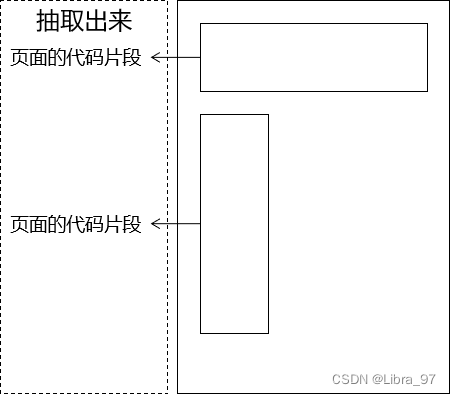
3.8.2 操作步骤
① 创建页面的公共代码片段
使用th:fragment来给这个片段命名:
<div th:fragment="header">
<p>被抽取出来的头部内容</p>
</div>
② 在需要的页面中进行包含
| 语法 | 效果 | 特点 |
|---|---|---|
| th:insert | 把目标的代码片段整个插入到当前标签内部 | 它会保留页面自身的标签 |
| th:replace | 用目标的代码替换当前标签 | 它不会保留页面自身的标签 |
| th:include | 把目标的代码片段去除最外层标签,然后再插入到当前标签内部 | 它会去掉片段外层标记,同时保留页面自身标记 |
页面代码举例:
<!-- 代码片段所在页面的逻辑视图 :: 代码片段的名称 -->
<div id="badBoy" th:insert="segment :: header">
div标签的原始内容
</div>
<div id="worseBoy" th:replace="segment :: header">
div标签的原始内容
</div>
<div id="worstBoy" th:include="segment :: header">
div标签的原始内容
</div>






















 431
431











 被折叠的 条评论
为什么被折叠?
被折叠的 条评论
为什么被折叠?








